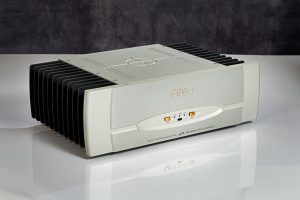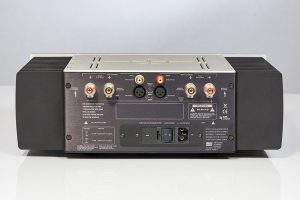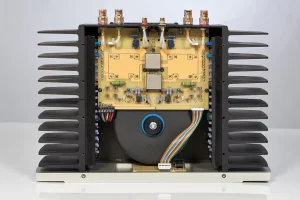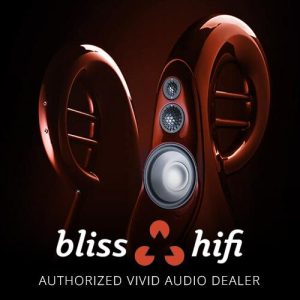Coda Technologies Class A S5.5 Amplifier By Terry London

 In the past, I have reviewed three Coda Technologies components (#8 amplifier-#16 amplifier-FET 07x preamplifier) and found them all to be superlative in build quality and performance, along with offering one of the highest, cost to performance ratios, found in high-end audio in today’s market. The subject of this review, the S5.5, is the least expensive, at $6,400, and the smallest single chassis amplifier that Coda offers in its stereo amplifier line. The Coda S5.5 dimensions are height 5.75″ x width 17.5″ x depth 12.5″. Its weight is 45 pounds. The S5.5 sent to me was the black version; it also comes in a matte silver finish, and the chassis had an overall luxurious appearance. The top plate has a laser engraved figure, and the front of the amplifier has two buttons that flank centered LEDs that indicate if the bias is on, which means that the S5.5 is out of standby mode, along with which input (RCA/XLR) has been selected. The buttons control these features. Around the back, there are RCA/XLR inputs, a pair of very high-grade speaker wire terminals, a power off/on switch, and the IEC power connection. The Coda S5.5 produces 50 watts Class A into 8 Ohms. It doubles down to 100 watts into 4 Ohms. Like all Coda amplifiers, it can produce a massive amount of current at a peak of 100 amperes per channel. This is based on a very robust power supply section. The S5.5 has a 1500 VA multi-tap toroidal transformer and 80,000uF capacitance reserve.
In the past, I have reviewed three Coda Technologies components (#8 amplifier-#16 amplifier-FET 07x preamplifier) and found them all to be superlative in build quality and performance, along with offering one of the highest, cost to performance ratios, found in high-end audio in today’s market. The subject of this review, the S5.5, is the least expensive, at $6,400, and the smallest single chassis amplifier that Coda offers in its stereo amplifier line. The Coda S5.5 dimensions are height 5.75″ x width 17.5″ x depth 12.5″. Its weight is 45 pounds. The S5.5 sent to me was the black version; it also comes in a matte silver finish, and the chassis had an overall luxurious appearance. The top plate has a laser engraved figure, and the front of the amplifier has two buttons that flank centered LEDs that indicate if the bias is on, which means that the S5.5 is out of standby mode, along with which input (RCA/XLR) has been selected. The buttons control these features. Around the back, there are RCA/XLR inputs, a pair of very high-grade speaker wire terminals, a power off/on switch, and the IEC power connection. The Coda S5.5 produces 50 watts Class A into 8 Ohms. It doubles down to 100 watts into 4 Ohms. Like all Coda amplifiers, it can produce a massive amount of current at a peak of 100 amperes per channel. This is based on a very robust power supply section. The S5.5 has a 1500 VA multi-tap toroidal transformer and 80,000uF capacitance reserve.
 The Coda #16 amplifier is one of the reference solid-state amplifiers I use in my big system. The Coda #16, like all the Coda amplifiers, offers to see through transparency that allows all the micro-details to be easily heard, a powerful bass extension that is accurate/tuneful, unbelievable transient speed, a pureness of tonality, a total lack of grain with an overall silkiness, and the ability to control and drive virtually any speaker load. Yet, unlike other highly resolving solid-state amplifiers, they never become analytical or fatiguing in their music presentation. It was very apparent that the Coda S5.5 had all these qualities plus the following fabulous sonic characteristics. First, the mid-range colors/timbres and the palpability of individual instruments rivaled some of the best tube-based amplifiers, including SET designs, I have heard in my systems. Secondly, the Coda S5.5’s top-end reproduction offered some of the most beautiful shimmer, colors, and decays, which gave me a sense that the delicate tremble/high frequencies were very close to the illusion of real instruments being played before me. The mid-range and tremble regions were seamlessly blended. The Coda S5.5 is a very linear-sounding amplifier from top to bottom. I drove the S5.5 with three different preamplifiers, both tube-based and solid state, and four different speakers, and the amplifier effortlessly controlled each pair of speakers and let the preamps add their own “spice” to the presentation of the music.
The Coda #16 amplifier is one of the reference solid-state amplifiers I use in my big system. The Coda #16, like all the Coda amplifiers, offers to see through transparency that allows all the micro-details to be easily heard, a powerful bass extension that is accurate/tuneful, unbelievable transient speed, a pureness of tonality, a total lack of grain with an overall silkiness, and the ability to control and drive virtually any speaker load. Yet, unlike other highly resolving solid-state amplifiers, they never become analytical or fatiguing in their music presentation. It was very apparent that the Coda S5.5 had all these qualities plus the following fabulous sonic characteristics. First, the mid-range colors/timbres and the palpability of individual instruments rivaled some of the best tube-based amplifiers, including SET designs, I have heard in my systems. Secondly, the Coda S5.5’s top-end reproduction offered some of the most beautiful shimmer, colors, and decays, which gave me a sense that the delicate tremble/high frequencies were very close to the illusion of real instruments being played before me. The mid-range and tremble regions were seamlessly blended. The Coda S5.5 is a very linear-sounding amplifier from top to bottom. I drove the S5.5 with three different preamplifiers, both tube-based and solid state, and four different speakers, and the amplifier effortlessly controlled each pair of speakers and let the preamps add their own “spice” to the presentation of the music.
 I was so struck with the Coda S5.5’s performance in the areas mentioned above that I asked Doug Dale, CEO/designer, what he had done differently, if anything, in the S5.5 compared to the other Coda amplifiers. What was the “secret sauce” to render these changes compared to the other Coda amplifiers?
I was so struck with the Coda S5.5’s performance in the areas mentioned above that I asked Doug Dale, CEO/designer, what he had done differently, if anything, in the S5.5 compared to the other Coda amplifiers. What was the “secret sauce” to render these changes compared to the other Coda amplifiers?

“The S5.5 uses transistors that are different from the other amplifiers. This pair of transistors is very similar to those used in the System amp architecture but is produced in a way that precludes them from being used in our other amplifiers. The fact that the S5.5 is a 50-watt amplifier and operates at a lower voltage allows us to use these components. The devices possess lower power handling than those used in the other amps. However, that has been resolved using more of them and the amplifier being 50 watts into an 8 Ohm load. CODA chose to use them because they have higher bandwidth, even better linearity, and allow zero global feedback. The resultant circuit closely approaches the performance of the System architecture in a smaller package. Running the S5.5 in Class A, in addition, produces a performance that is at once very low distortion and free of crossover notch distortion that is unavoidable in AB. The response to the amplifier is an example of folks experiencing this difference. It is, in fact, different than all of our other amps at a lower power.
Many audiophiles chase very high power. Even with very dynamic music, the power used is usually relatively low. That is likely why people are experiencing startling results with this amp.”
 Over the past couple of years, I received numerous emails from Stereo Times readers and many Audiogon members. I was curious about the performance of the Coda S5.5 compared to the other Coda amplifiers I had reviewed. Many were interested in purchasing the S5.5 based on its smaller size and price compared to the larger and more expensive Coda #8/#16 amplifiers. I was so impressed with the S5.5 performance that I started a thread on Audiogon entitled “The new Coda S5.5 amplifier – It’s a Petite Beast!” It shared a few details regarding the superlative performance of the S5.5 and that my Stereo Times review would go into much more depth and information about the amplifier. I started receiving emails from individuals who had purchased the Coda S5.5 and were enthralled by its performance in their system. What I found pretty interesting was the diversity of speakers being driven (single driver/planar/open baffle/ported/sealed), and the virtues of the Coda S5.5 were heard by all these listeners in their rigs.
Over the past couple of years, I received numerous emails from Stereo Times readers and many Audiogon members. I was curious about the performance of the Coda S5.5 compared to the other Coda amplifiers I had reviewed. Many were interested in purchasing the S5.5 based on its smaller size and price compared to the larger and more expensive Coda #8/#16 amplifiers. I was so impressed with the S5.5 performance that I started a thread on Audiogon entitled “The new Coda S5.5 amplifier – It’s a Petite Beast!” It shared a few details regarding the superlative performance of the S5.5 and that my Stereo Times review would go into much more depth and information about the amplifier. I started receiving emails from individuals who had purchased the Coda S5.5 and were enthralled by its performance in their system. What I found pretty interesting was the diversity of speakers being driven (single driver/planar/open baffle/ported/sealed), and the virtues of the Coda S5.5 were heard by all these listeners in their rigs.
The following are some of the comments regarding the performance of the Coda S5.5 mentioned on that thread:
“Love it, can’t believe the price/performance value that it offers.”
“The tonal verisimilitude of the acoustic instruments was breathtaking.“
“So airy and detailed with great sparkle without sounding harsh or in your face.”
“The sound is very smooth and extended in highs and lows with tube-like mid-range. No edginess or brightness. Very dynamic and clean.“
“The S5.5 is fantastic and I enjoy my setup more now than ever before.“
“Crystal clear, clean highs with no grain or fatigue. Mids match the high frequency in the openness and silky smoothness and more detail than I’ve ever experienced.“
“Bass is tight, tuneful, and full.“
“Bass is punchy, quick, tight, detailed, and effortless.“
“Transients are quick and very dynamic, there is nothing slow about this amp at all.“
“Midrange and highs: Holy Shite! Vocals are ethereal with wonderful tone and liquidity. Highs are extremely detailed and airy, yet the notes’ beginning and end are all there.“
“Sound staging is wider despite the less than perfect room.“
“The S5.5 does everything my Accuphase does then improves on it.“
“The S5.5 has been a revelation in my system.”
 I believe the Coda S5.5 is an exceptional amplifier because it offers the Coda “house sound,” which includes reference level transparency/micro-details, a grainless/silky perspective, transient speed, and the ability to scale to large crescendos, purity of tonality, and accurate extended bass. The Coda S5.5 then provides a qualitative shift to a higher level of refinement in the mid-range and high frequencies regarding gorgeous tonality/timbres, a tube-like image palpability with air around the instruments, and a treble that has an exceptional sparkling-shimmering quality, with highly resolved micro-details, and beautiful decays. Based on my own auditioning experience, along with numerous accounts by owners of the S5.5, the combination of Class A watts and 100 amperes of current allows the S5.5 amplifier to drive virtually any speaker effortlessly to high volume levels. Because of its tiny footprint, overall weight, and excellent performance, I nicknamed the Coda S5.5 the “Petite Beast.” I will be purchasing the S5.5 because of its unique qualities and consider this amplifier a bargain for its asking price compared to what it delivers in its performance.
I believe the Coda S5.5 is an exceptional amplifier because it offers the Coda “house sound,” which includes reference level transparency/micro-details, a grainless/silky perspective, transient speed, and the ability to scale to large crescendos, purity of tonality, and accurate extended bass. The Coda S5.5 then provides a qualitative shift to a higher level of refinement in the mid-range and high frequencies regarding gorgeous tonality/timbres, a tube-like image palpability with air around the instruments, and a treble that has an exceptional sparkling-shimmering quality, with highly resolved micro-details, and beautiful decays. Based on my own auditioning experience, along with numerous accounts by owners of the S5.5, the combination of Class A watts and 100 amperes of current allows the S5.5 amplifier to drive virtually any speaker effortlessly to high volume levels. Because of its tiny footprint, overall weight, and excellent performance, I nicknamed the Coda S5.5 the “Petite Beast.” I will be purchasing the S5.5 because of its unique qualities and consider this amplifier a bargain for its asking price compared to what it delivers in its performance.


Specifications:
Price: $6,400
Rated Power: 50 Watts Class A into 8 Ohms, 100 Watts per channel into 4 Ohms
200 Watts per channel into 2 Ohms
Frequency Response: -3dB @ DC to 100kHz
Distortion: < .04% from 10Hz to 20kHz @ 50W
Gain: 26dB
Maximum Current: 100 Amperes peak per channel
Noise: Less than 120dB referenced to rated output
Input Impedance: 50k Ohms unbalanced/10k Ohms balanced
Output Impedance: .04 Ohms from 20Hz to 20kHz
BRIDGED MONO
Rated Power: 200 Watts into 8 Ohms, 400 Watts mono in bridged mode into 4 Ohms
Frequency Response: -3dB @ DC to 100kHz
Distortion: < .04% from 10Hz to 20kHz @ 50W
Gain: 26dB
Maximum Current: 100 Amperes peak per channel
Noise: Less than 120dB referenced to rated output
Input Impedance: 50k Ohms unbalanced/10k Ohms balanced
Output Impedance: .04 Ohms from 20Hz to 20kHz
POWER SUPPLY
Transformer Type: Multi-tap, multi-winding toroidal
Transformer Rating: 1500 VA
Power Filtering: 80,000 microfarad
DIMENSIONS
Height: 5.75″
Width: 17.5″
Depth: 12.5”
Weight: 45 lbs
Power requirement: 450 Watts maximum at rated power
Double-sided gold-plated circuit
All anodized chassis
10-year warranty / 5-year transferable
Designed, manufactured, and assembled in the USA
Website: https://coda.cc/
TJ’s Associated Equipment:
Sources:
Reimyo DAP-999EX Limited “Toka“ DAC
Pass Labs DAC-1
Mark Levinson 31.5 transport
Pro-Ject reference CD transport & Linear Tube Design Power Supply
CEC-3 belt-driven transport
Amplification:
Coda #16 amplifier
Coda FET 07X preamplifier
SPL Elector preamplifier
SPL S1200 amplifier
AricAudio Super SET 300B amplifier
AricAudio Motherlode MKII preamplifier
Loudspeakers:
Tekton Design Ulfberth
NSMT Clairvoyant System Two & Double Two band pass subwoofers
Musician Audio- Knight One speaker
Accessories:
Jena Labs reference AES/EBU digital cable – Black Cat 3202 XLR IC’s
Krimuss Audio Adrenaline speaker wire
Krolo Design reference rack & footers
Puritan Audio power conditioner & circuit grounding system
Audio Archon power cords
Stereo Times Masthead
Publisher/Founder
Clement Perry
Editor
Dave Thomas
Senior Editors
Frank Alles, Mike Girardi, John Hoffman, Russell Lichter, Terry London, Moreno Mitchell, Paul Szabady, Bill Wells, Mike Wright, Stephen Yan, and Rob Dockery
Current Contributors
David Abramson, Tim Barrall, Dave Allison, Ron Cook, Lewis Dardick, Dan Secula, Don Shaulis, Greg Simmons, Eric Teh, Greg Voth, Richard Willie, Ed Van Winkle, and Rob Dockery
Music Reviewers:
Carlos Sanchez, John Jonczyk, John Sprung and Russell Lichter
Site Management Clement Perry
Ad Designer: Martin Perry






Be the first to comment on: Coda Technologies Class A S5.5 Amplifier By Terry London